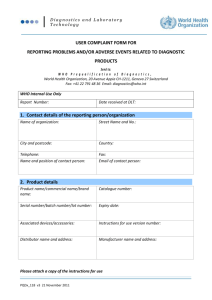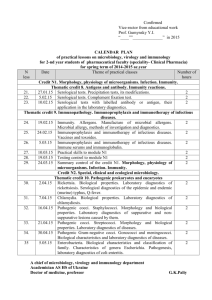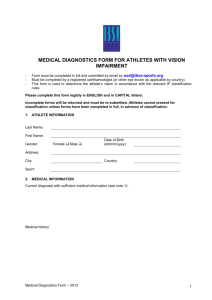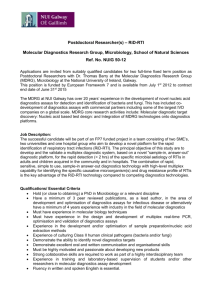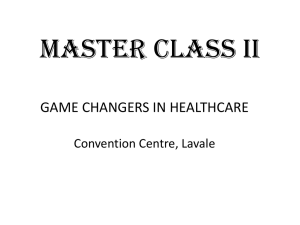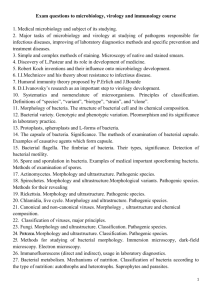Confirmed
advertisement
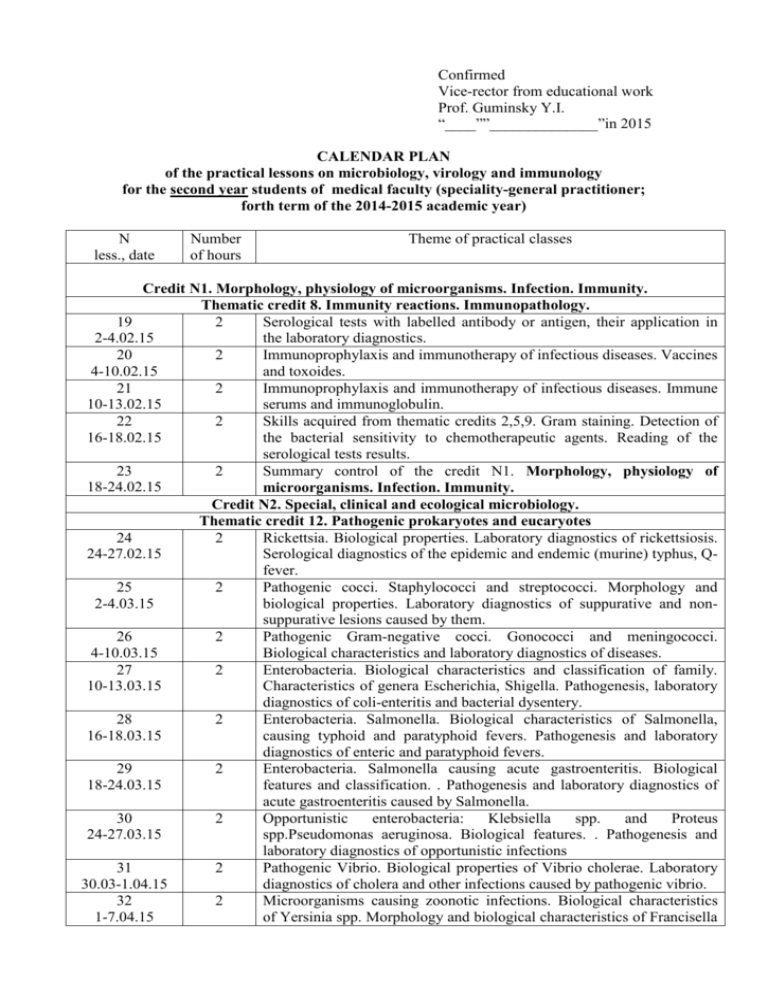
Confirmed Vice-rector from educational work Prof. Guminsky Y.I. “____””______________”in 2015 CALENDAR PLAN of the practical lessons on microbiology, virology and immunology for the second year students of medical faculty (speciality-general practitioner; forth term of the 2014-2015 academic year) N less., date Number of hours Theme of practical classes Credit N1. Morphology, physiology of microorganisms. Infection. Immunity. Thematic credit 8. Immunity reactions. Immunopathology. 19 2 Serological tests with labelled antibody or antigen, their application in 2-4.02.15 the laboratory diagnostics. 20 2 Immunoprophylaxis and immunotherapy of infectious diseases. Vaccines 4-10.02.15 and toxoides. 21 2 Immunoprophylaxis and immunotherapy of infectious diseases. Immune 10-13.02.15 serums and immunoglobulin. 22 2 Skills acquired from thematic credits 2,5,9. Gram staining. Detection of 16-18.02.15 the bacterial sensitivity to chemotherapeutic agents. Reading of the serological tests results. 23 2 Summary control of the credit N1. Morphology, physiology of 18-24.02.15 microorganisms. Infection. Immunity. Credit N2. Special, clinical and ecological microbiology. Thematic credit 12. Pathogenic prokaryotes and eucaryotes 24 2 Rickettsia. Biological properties. Laboratory diagnostics of rickettsiosis. 24-27.02.15 Serological diagnostics of the epidemic and endemic (murine) typhus, Qfever. 25 2 Pathogenic cocci. Staphylococci and streptococci. Morphology and 2-4.03.15 biological properties. Laboratory diagnostics of suppurative and nonsuppurative lesions caused by them. 26 2 Pathogenic Gram-negative cocci. Gonococci and meningococci. 4-10.03.15 Biological characteristics and laboratory diagnostics of diseases. 27 2 Enterobacteria. Biological characteristics and classification of family. 10-13.03.15 Characteristics of genera Escherichia, Shigella. Pathogenesis, laboratory diagnostics of coli-enteritis and bacterial dysentery. 28 2 Enterobacteria. Salmonella. Biological characteristics of Salmonella, 16-18.03.15 causing typhoid and paratyphoid fevers. Pathogenesis and laboratory diagnostics of enteric and paratyphoid fevers. 29 2 Enterobacteria. Salmonella causing acute gastroenteritis. Biological 18-24.03.15 features and classification. . Pathogenesis and laboratory diagnostics of acute gastroenteritis caused by Salmonella. 30 2 Opportunistic enterobacteria: Klebsiella spp. and Proteus 24-27.03.15 spp.Pseudomonas aeruginosa. Biological features. . Pathogenesis and laboratory diagnostics of opportunistic infections 31 2 Pathogenic Vibrio. Biological properties of Vibrio cholerae. Laboratory 30.03-1.04.15 diagnostics of cholera and other infections caused by pathogenic vibrio. 32 2 Microorganisms causing zoonotic infections. Biological characteristics 1-7.04.15 of Yersinia spp. Morphology and biological characteristics of Francisella tularensis.Pathogenesis and laboratory diagnostics of a plaque, enteric yersiniosis, pseudotuberculosis and tularemia. 33 2 Microorganisms causing zoonotic infections. Brucella spp. Bacillus 7-10.04.15 anthracis. Biological properties of microorganisms. Pathogenesis, laboratory diagnostics and specific prevention of brucellosis and anthrax. 34 2 Medical-important clostridia. Biological characteristics Clostridium 13-15.04.15 tetani and Clostridium botulinum. Pathogenesis, laboratory diagnostics and specific prevention of tetanus and botulism. 35 2 Anaerobic rods causing purulent wound infections and gas gangrene. 15-21.04.15 Pathogenesis, laboratory diagnostics and specific prevention of gas gangrene and wound infections. 36 2 Corynebacterium diphtheria. Bordetella spp. Biological characteristics. 21-24.04.15 Pathogenesis, laboratory diagnostics, specific therapy and prevention of diphtheria and whooping cough. 37 2 Mycobacteria. Causative agents of tuberculosis and leprosy, their 27-29.04.15 biological properties. Pathogenesis, laboratory diagnostics, specific prevention of diseases. 38 2 Medical-important spirochetes. Biological characteristics of Treponema 29.04-5.05.15 pallidum. Pathogenesis and laboratory diagnostics of syphilis. 39 2 Pathogenic spirochetes. Characteristics of genera Leptospira and 5-8.05.15 Borellia. Pathogenesis, laboratory diagnostics of relapsing fever, Lyme disease, and leptospirosis. 40 2 Pathogenic Spirilla. Campylobacteria and helicobacteria. Morphology 11-13.05.15 and biological properties. Laboratory diagnostics. 41 2 Pathogenic actinomycetes and fungi of genus Candida. Morphology and 13-19.05.15 biological properties. Laboratory diagnostics of infections caused by them. 42 2 Pathogenic fungi. Classification and biological properties of medical19-22.05.15 important fungi. Dermatophytes and fungi causing deep mycoses.. Laboratory diagnostics of candidosis and dermatophytosis. 43 2 The most medical-important protozoa. Causative agents of malaria and 25-27.05.15 toxoplasmosis. Features of laboratory diagnostics of protozoan infections. 44 2 The most medical-important protozoa. Causative agents of amebiasis, 27.05-2.06.15 giardiasis, leshmaniasis, trypanosomiasis, and balantidiasis. Features of laboratory diagnostics of protozoan infections. Thematic credit 13. Clinical and ecological microbiology. Introduction. 45 2 Summary control of the credit N2. Special, clinical and ecological 2-5.06.15 microbiology A chief of microbiology, virology and immunology department Academician AS HS of Ukraine Doctor of medicine, professor G.K.Paliy
